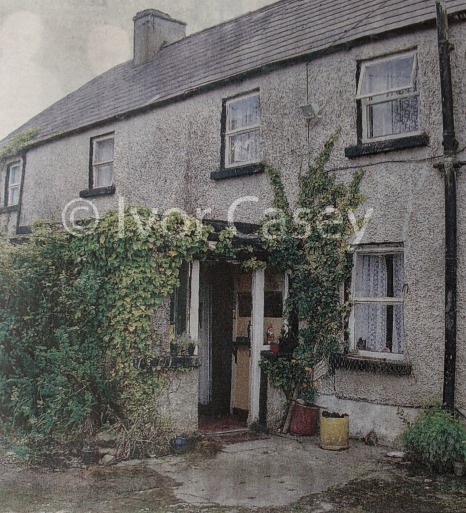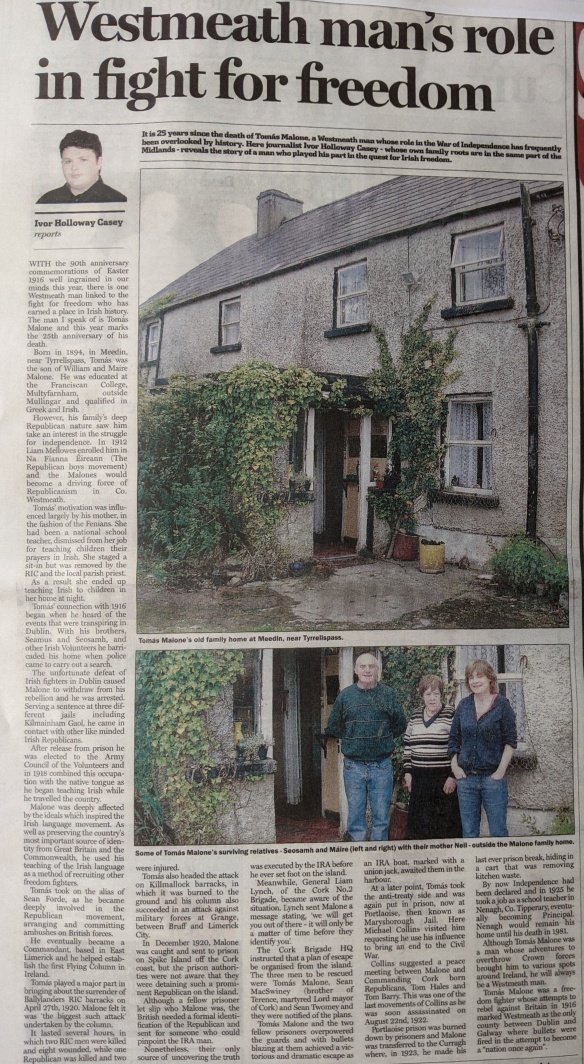WESTMEATH is not usually considered when it comes to remembering the 1916 Rising but there is certainly one Westmeath man linked to the fight for an independent Ireland who had much involvement. In what is the 30th anniversary of his death, the man I refer to is Tomás Malone. Born in 1896, in Meedin, near Tyrrellspass, Tomás was the son of William and Máire Malone. He was educated at the Franciscan College, Multyfarnham and became qualified in Greek and Irish. However, his family’s deep Republican nature saw him take an interest in the struggle for Independence. In 1912, Liam Mellows, founder member of the Irish volunteers, enrolled him in ‘Na Fianna Éireann’ (The Republican boys movement) and the Malones would become a driving force of Republicanism in Co. Westmeath.

House of Tomás Malone in Meedin, Tyrrellspass, Co. Westmeath (Photo: Ivor Casey, 2006)
Tomás’ motivation was influenced largely by his mother. She had been a national school teacher, dismissed from her job for teaching children their prayers in Irish. She staged a sit in but was removed by the RIC (Royal Irish Constabulary) and the local Catholic priest. As a result she ended up teaching Irish to children in her home at night. Tomás’ connection with 1916 began when he heard of the events that were transpiring in Dublin. With his brothers, Séamus and Seosamh, and other Irish Volunteers he barricaded his home when police came to carry out a search. The defeat of Irish fighters in Dublin caused Malone to withdraw from his rebellion and he was arrested. Serving a sentence at three different jails including Kilmainham Gaol, he came in contact with other like minded Irish Republicans. After release from prison he was elected to the Army Council of the Volunteers and in 1918 combined this occupation with the native tongue as he began teaching Irish while he travelled the country. Malone was deeply affected by the ideals which inspired the Irish language movement. As well as preserving, arguably, the country’s most important source of identity from Great Britain he used his teaching of the Irish language as a method of recruiting other “freedom fighters”.
Tomás took on the alias of Sean Forde, as he became deeply involved in the Republican movement, arranging and committing ambushes on British forces. He eventually became a Commandant, based in East Limerick and he helped establish the first Flying Column in Ireland. Tomás played a major part in bringing about the surrender of Ballylanders RIC barracks on 27 April 1920. He felt it was ‘the biggest such attack’ undertaken by the column. It lasted several hours, in which two RIC men were killed and eight wounded, while one Republican was killed and two were injured. Tomás also headed the attack on Killmallock barracks, in which it was burned to the ground. His column also succeeded in an attack against military forces at Grange, between Bruff and Limerick City.
In December 1920, Malone was caught and sent to prison on Spike Island off the Cork coast, but the prison authorities were not aware that they were detaining such a notorious Republican on the island. Although a fellow prisoner let slip who Malone was, the British needed a formal identification of the Republican and sent for someone who could pinpoint the IRA man. Nonetheless, their only source of uncovering the truth was executed by the IRA before he reached the island. In the meantime, General Liam Lynch, of the Cork No.2 Brigade, became aware of the circumstances. Lynch sent Malone a message stating, ‘we will get you out of there – it will only be a matter of time before they identify you’. The Cork Brigade HQ instructed that a plan of escape be organised from the island. The three men to be rescued were Tomás Malone, Sean Twomey and Sean MacSwiney, the brother of the martyred Cork Lord Mayor, Terence. On 29 April 1921, Tomás Malone and the two fellow prisoners, were outside working on the prison grounds when they overpowered the guards and achieved a victorious and dramatic escape as an IRA boat, marked with a union jack, awaited them in the harbour.
At a later point, Tomás took the anti-treaty side and was again put in prison, now at Portlaoise, then known as Marysborough Jail. Here Michael Collins visited him requesting he use his influence to bring an end to the Civil War. Collins suggested a peace meeting between Malone and Commanding Cork born Republicans, Tom Hales and Tom Barry. This was one of the last movements of Collins as he was soon assassinated on 22 August 1922. Portlaoise prison was burned down by prisoners and Malone was transferred to the Curragh where, in 1923, he made his last ever prison break, hiding in a cart that was removing kitchen waste. By now Independence had been declared and in 1925 he took a job as a school teacher in Nenagh, Co. Tipperary, eventually becoming Principal. Nenagh would remain his home until his death in 1981. Although Tomás Malone was a man whose adventures to overthrow Crown forces brought him to various spots around Ireland, he will always be a Westmeath man. Tomás Malone’s attempts to rebel against Britain in 1916 marked Westmeath as the only county between Dublin and Galway where bullets were fired in the attempt for Ireland to become an independent nation.
– Ivor Casey
(Amended from an article by Ivor Casey previously printed in The Westmeath Independent, The Westmeath Examiner and Ireland’s Own)

(Original publication of ‘Westmeath’s link to the 1916 Rising’ by Ivor Casey, as seen in the The Westmeath Independent in 2006)


